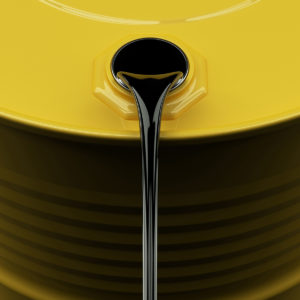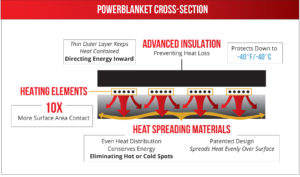The Need for Better Tank Insulation Solutions
If you’re looking for the best freeze protection this winter, then this post is for you. Too many of our customers have had their tanks and IBC totes freeze and crack during the winter months because they don’t know how to prevent it. In this blog post, we’ll provide some tips on how to keep your tanks and IBC totes safe from freezing while also providing some solutions that might work better than others.
What is the importance of insulating tanks?
The key word here is viscosity. Viscosity is the thickness of liquids often stored inside of tanks and totes. The colder a liquid generally is, the thicker it is, giving it what we call low viscosity. The warmer a liquid is, the more runny it is, which is what is called high viscosity.
Liquids that have too low of a viscosity won’t perform as needed. Various oils need to be kept within specific temperature ranges to stay usable. Just imagine opening the cap on an IBC tote only to find that your materials have gotten too cold. Now, instead of quickly flowing into connected pipe, your materials slowly take their time to leave the tote. What could have taken minutes will now take hours, causing delays that will increase your operating costs.
Even worse things can happen, such as when materials have frozen inside your storage tank, causing the tank to crack. Insulation helps fight against cold, but it’s not an end-all solution. As you’ll read below, it should also help recover lost heat when the temperatures drop below what your insulation can handle.
Why insulation-only protection is old news
There are a few things to consider when it comes to freeze protection for IBC tote tanks. First off, let’s talk about why your tank could be at risk of losing heat in the first place. Cold temperatures resulting from either the work environment or extreme weather can thicken materials, decreasing their viscosity. Some materials expand when they get cold, which could potentially cause cracking in your tanks and totes, making for an extremely dangerous situation.
You can protect your tanks and IBC totes from cracking by selecting the right type of insulating system. When looking for the best in storage tank insulation for your needs, you must first see what type of material makes up the cover.
Rely on Durable, Weather-proof Covers
A tear or other issue with the insulation cover will allow heat escape from insulated tanks and totes. Insulation such as fiberglass, mineral wool, or foam will fail once the outer layer of the insulative fabric cover is punctured. Too often, an insulated tank cover left out in an extreme weather event will rip open when pitted against ice and wind. These tears only increase the chances of your materials from being compromised and allowing internal materials like water to expand as they freeze, potentially cracking your tank or tote.
Insulated tank heating blankets from Powerblanket don’t have this problem. Powerblankets are covered with a rugged, vinyl shell built to endure the worst Mother Nature can throw at it, and are even able to withstand hurricane-force winds. This protective layer ensures cracks and tears don’t happen, keeping storage tote and tank temperatures warm and materials at the right level of viscosity for immediate use.
Total Tank Temperature Control
Additionally, all tank insulation systems from Powerblanket are built with internal heating elements. No insulation is truly effective against cold weather unless there is a way to raise temperatures. With a layer of heating elements between the insulation and the tank, cold weather doesn’t stand a chance.
With the combined power of vinyl covers, heating elements, and top-rated insulation, Powerblanket tank heating blankets are your best answer to the age-old question, how to keep water tanks from freezing (or any other kind of tank or tote).
Insulation FAQs
-
What is an insulated tank?
- An insulated tank is a storage tank that has some type of cover over it that resists heat loss.
-
What is an insulated thermal tank?
- An insulated thermal tank has heating chambers that help raise and lower temperatures inside the tank.
-
Should you insulate under a cold water tank?
- Yes, as ground temperatures will be cold in freezing conditions. Insulation lowers the amount of heat leaving the tank as external cold temperatures draw heat away. Without another source of heat, however, insulation can only be used to slowly lose the battle against the elements.
-
Which insulation is used in storing a water heater?
- Fiberglass insulation and mineral wool are common in wraps and blankets used to protect water tanks and heaters.
-
What type of insulation should I use to keep my materials warm?
- Any insulation will help prevent too much heat loss, but being able to provide heat isn’t just an effective solution: it makes so much more sense. Choose insulation that has the capability to add heat when necessary.
Get the best storage tank insulation with Powerblanket
Old tank heating solutions are ineffective. As soon as the outer jacket becomes compromised, it becomes impossible to control what you’re storing in your tanks and totes. Thankfully, we don’t allow for compromise in our insulated heating blankets. That’s why our products are crucial to keeping your business running smoothly.
Powerblanket eliminates costly weather delays, ensures your project proceeds on schedule, and provides an insulation and heating solution that will be long-lasting and durable all through high quality temperature control products. Contact us to find the right heating solution for your needs at 877.728.2055 or [email protected].
Frequently Asked Questions
How do you insulate an IBC tote?
To insulate an IBC tote, use durable, weather-proof insulated covers or blankets that can withstand harsh conditions and prevent heat loss, ensuring the contents remain at a stable temperature.
How do I keep my IBC tote from freezing in the winter?
To prevent an IBC tote from freezing in winter, employ electric heating jackets or blankets that provide both insulation and active temperature control, maintaining optimal material viscosity.
What is the life expectancy of an IBC tote?
With proper care and maintenance, IBC totes made from high-density polyethylene (HDPE) can last between 5 to 10 years or more, depending on usage and environmental conditions.
Are IBC totes airtight?
Yes, IBC totes are designed to be airtight, using gaskets and O-ring seals at the lid and drain valve to prevent contamination and maintain the quality of the contents.
Keep your temperature-sensitive materials at the right temperature with Powerblanket IBC tote warmers and heaters.




